Organisational Change Management: Challenges and Strategies Report
VerifiedAdded on 2020/03/04
|8
|2069
|104
Report
AI Summary
This report delves into the multifaceted realm of organisational change management, emphasizing the significance of organisational culture and its impact on employee behavior and performance. It highlights key characteristics of organisational culture, such as innovation, attention to detail, and emphasis on outcomes, and discusses their influence on the workplace. The report also examines the challenges of change, particularly employee resistance, and identifies contributing factors like lack of communication, fear of the unknown, and inconsistent values. It proposes strategies to mitigate resistance, including improved communication, employee involvement, and performance-based incentives. Furthermore, the report underscores the importance of understanding external and internal forces that necessitate change and emphasizes the need for effective management to achieve successful outcomes, contributing to a positive brand image.
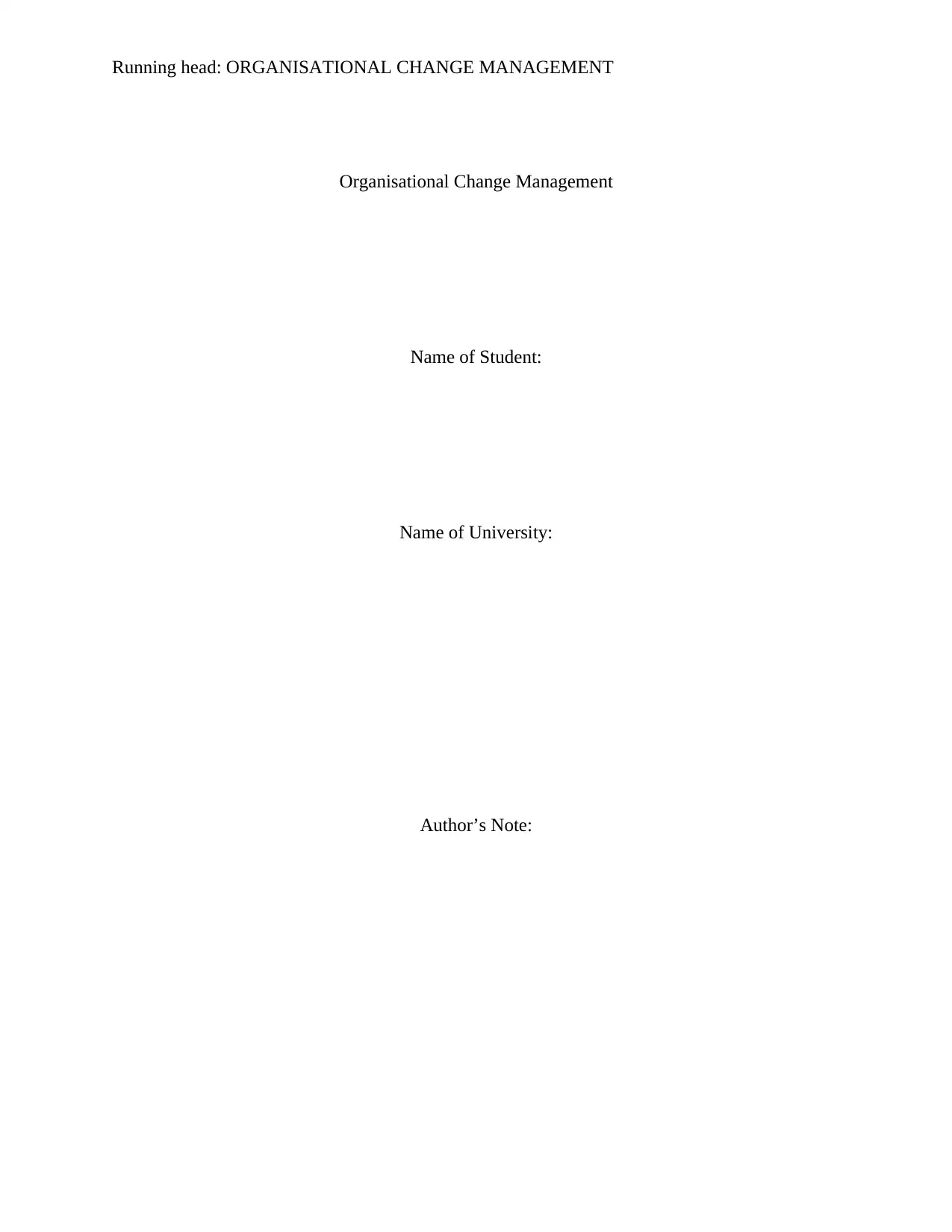
Running head: ORGANISATIONAL CHANGE MANAGEMENT
Organisational Change Management
Name of Student:
Name of University:
Author’s Note:
Organisational Change Management
Name of Student:
Name of University:
Author’s Note:
Paraphrase This Document
Need a fresh take? Get an instant paraphrase of this document with our AI Paraphraser
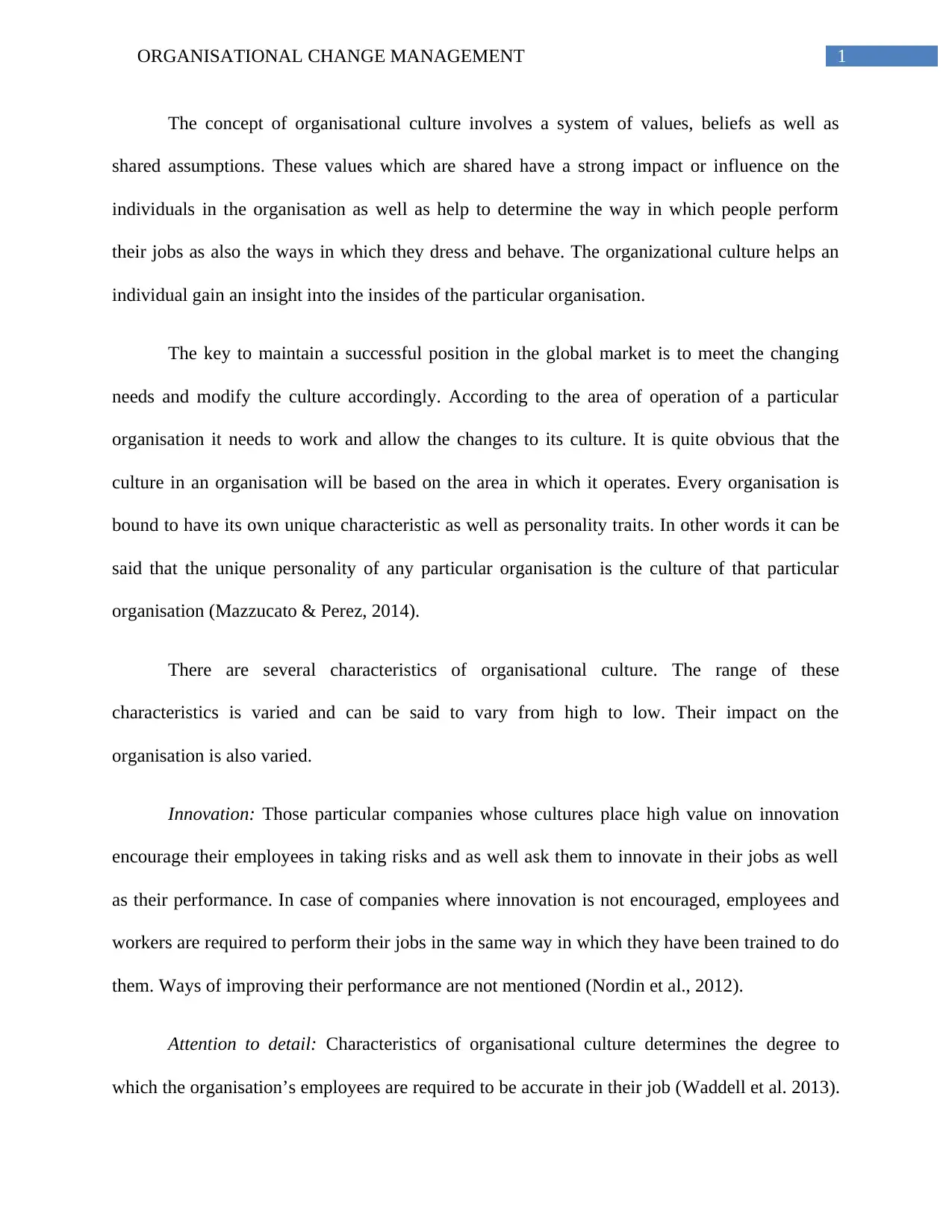
1ORGANISATIONAL CHANGE MANAGEMENT
The concept of organisational culture involves a system of values, beliefs as well as
shared assumptions. These values which are shared have a strong impact or influence on the
individuals in the organisation as well as help to determine the way in which people perform
their jobs as also the ways in which they dress and behave. The organizational culture helps an
individual gain an insight into the insides of the particular organisation.
The key to maintain a successful position in the global market is to meet the changing
needs and modify the culture accordingly. According to the area of operation of a particular
organisation it needs to work and allow the changes to its culture. It is quite obvious that the
culture in an organisation will be based on the area in which it operates. Every organisation is
bound to have its own unique characteristic as well as personality traits. In other words it can be
said that the unique personality of any particular organisation is the culture of that particular
organisation (Mazzucato & Perez, 2014).
There are several characteristics of organisational culture. The range of these
characteristics is varied and can be said to vary from high to low. Their impact on the
organisation is also varied.
Innovation: Those particular companies whose cultures place high value on innovation
encourage their employees in taking risks and as well ask them to innovate in their jobs as well
as their performance. In case of companies where innovation is not encouraged, employees and
workers are required to perform their jobs in the same way in which they have been trained to do
them. Ways of improving their performance are not mentioned (Nordin et al., 2012).
Attention to detail: Characteristics of organisational culture determines the degree to
which the organisation’s employees are required to be accurate in their job (Waddell et al. 2013).
The concept of organisational culture involves a system of values, beliefs as well as
shared assumptions. These values which are shared have a strong impact or influence on the
individuals in the organisation as well as help to determine the way in which people perform
their jobs as also the ways in which they dress and behave. The organizational culture helps an
individual gain an insight into the insides of the particular organisation.
The key to maintain a successful position in the global market is to meet the changing
needs and modify the culture accordingly. According to the area of operation of a particular
organisation it needs to work and allow the changes to its culture. It is quite obvious that the
culture in an organisation will be based on the area in which it operates. Every organisation is
bound to have its own unique characteristic as well as personality traits. In other words it can be
said that the unique personality of any particular organisation is the culture of that particular
organisation (Mazzucato & Perez, 2014).
There are several characteristics of organisational culture. The range of these
characteristics is varied and can be said to vary from high to low. Their impact on the
organisation is also varied.
Innovation: Those particular companies whose cultures place high value on innovation
encourage their employees in taking risks and as well ask them to innovate in their jobs as well
as their performance. In case of companies where innovation is not encouraged, employees and
workers are required to perform their jobs in the same way in which they have been trained to do
them. Ways of improving their performance are not mentioned (Nordin et al., 2012).
Attention to detail: Characteristics of organisational culture determines the degree to
which the organisation’s employees are required to be accurate in their job (Waddell et al. 2013).
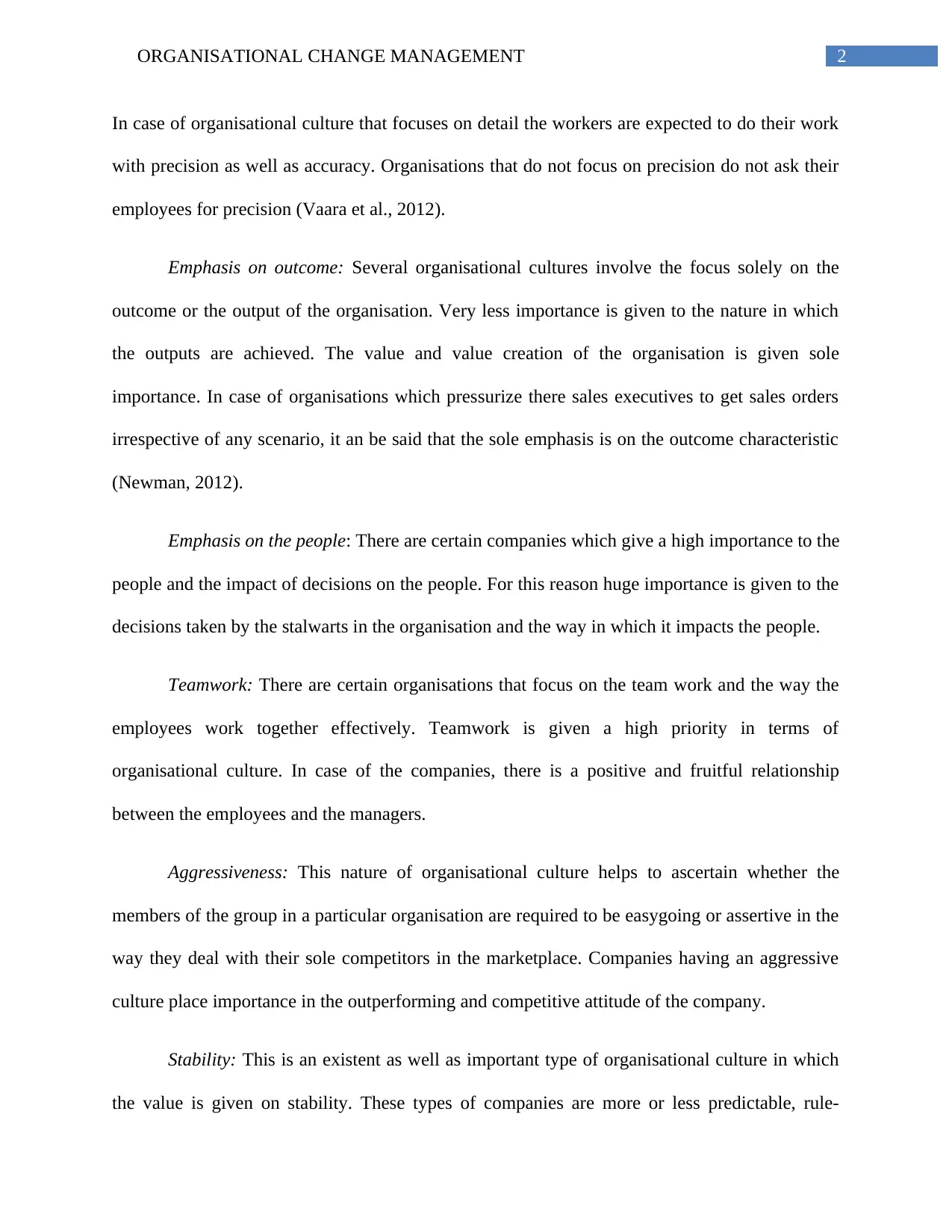
2ORGANISATIONAL CHANGE MANAGEMENT
In case of organisational culture that focuses on detail the workers are expected to do their work
with precision as well as accuracy. Organisations that do not focus on precision do not ask their
employees for precision (Vaara et al., 2012).
Emphasis on outcome: Several organisational cultures involve the focus solely on the
outcome or the output of the organisation. Very less importance is given to the nature in which
the outputs are achieved. The value and value creation of the organisation is given sole
importance. In case of organisations which pressurize there sales executives to get sales orders
irrespective of any scenario, it an be said that the sole emphasis is on the outcome characteristic
(Newman, 2012).
Emphasis on the people: There are certain companies which give a high importance to the
people and the impact of decisions on the people. For this reason huge importance is given to the
decisions taken by the stalwarts in the organisation and the way in which it impacts the people.
Teamwork: There are certain organisations that focus on the team work and the way the
employees work together effectively. Teamwork is given a high priority in terms of
organisational culture. In case of the companies, there is a positive and fruitful relationship
between the employees and the managers.
Aggressiveness: This nature of organisational culture helps to ascertain whether the
members of the group in a particular organisation are required to be easygoing or assertive in the
way they deal with their sole competitors in the marketplace. Companies having an aggressive
culture place importance in the outperforming and competitive attitude of the company.
Stability: This is an existent as well as important type of organisational culture in which
the value is given on stability. These types of companies are more or less predictable, rule-
In case of organisational culture that focuses on detail the workers are expected to do their work
with precision as well as accuracy. Organisations that do not focus on precision do not ask their
employees for precision (Vaara et al., 2012).
Emphasis on outcome: Several organisational cultures involve the focus solely on the
outcome or the output of the organisation. Very less importance is given to the nature in which
the outputs are achieved. The value and value creation of the organisation is given sole
importance. In case of organisations which pressurize there sales executives to get sales orders
irrespective of any scenario, it an be said that the sole emphasis is on the outcome characteristic
(Newman, 2012).
Emphasis on the people: There are certain companies which give a high importance to the
people and the impact of decisions on the people. For this reason huge importance is given to the
decisions taken by the stalwarts in the organisation and the way in which it impacts the people.
Teamwork: There are certain organisations that focus on the team work and the way the
employees work together effectively. Teamwork is given a high priority in terms of
organisational culture. In case of the companies, there is a positive and fruitful relationship
between the employees and the managers.
Aggressiveness: This nature of organisational culture helps to ascertain whether the
members of the group in a particular organisation are required to be easygoing or assertive in the
way they deal with their sole competitors in the marketplace. Companies having an aggressive
culture place importance in the outperforming and competitive attitude of the company.
Stability: This is an existent as well as important type of organisational culture in which
the value is given on stability. These types of companies are more or less predictable, rule-
⊘ This is a preview!⊘
Do you want full access?
Subscribe today to unlock all pages.

Trusted by 1+ million students worldwide
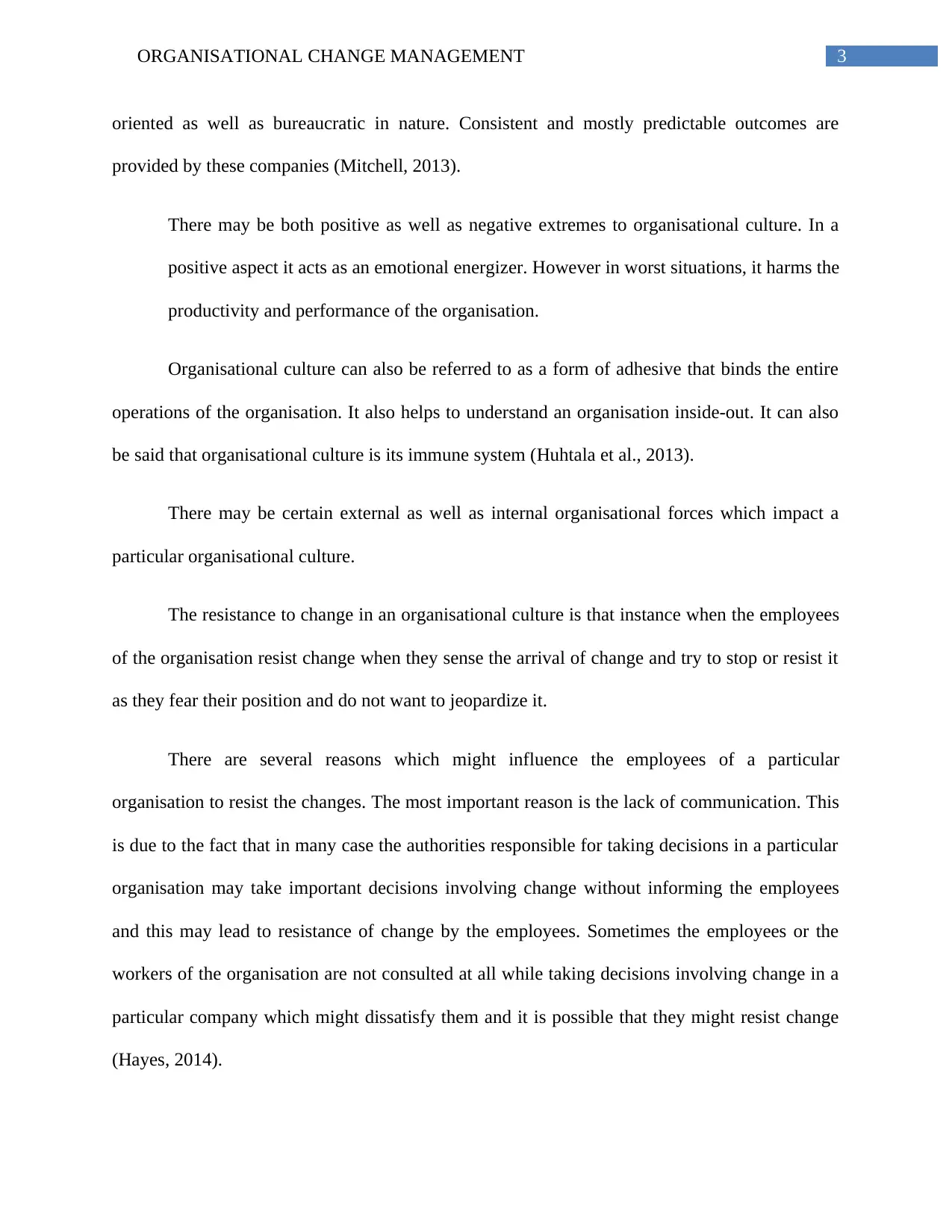
3ORGANISATIONAL CHANGE MANAGEMENT
oriented as well as bureaucratic in nature. Consistent and mostly predictable outcomes are
provided by these companies (Mitchell, 2013).
There may be both positive as well as negative extremes to organisational culture. In a
positive aspect it acts as an emotional energizer. However in worst situations, it harms the
productivity and performance of the organisation.
Organisational culture can also be referred to as a form of adhesive that binds the entire
operations of the organisation. It also helps to understand an organisation inside-out. It can also
be said that organisational culture is its immune system (Huhtala et al., 2013).
There may be certain external as well as internal organisational forces which impact a
particular organisational culture.
The resistance to change in an organisational culture is that instance when the employees
of the organisation resist change when they sense the arrival of change and try to stop or resist it
as they fear their position and do not want to jeopardize it.
There are several reasons which might influence the employees of a particular
organisation to resist the changes. The most important reason is the lack of communication. This
is due to the fact that in many case the authorities responsible for taking decisions in a particular
organisation may take important decisions involving change without informing the employees
and this may lead to resistance of change by the employees. Sometimes the employees or the
workers of the organisation are not consulted at all while taking decisions involving change in a
particular company which might dissatisfy them and it is possible that they might resist change
(Hayes, 2014).
oriented as well as bureaucratic in nature. Consistent and mostly predictable outcomes are
provided by these companies (Mitchell, 2013).
There may be both positive as well as negative extremes to organisational culture. In a
positive aspect it acts as an emotional energizer. However in worst situations, it harms the
productivity and performance of the organisation.
Organisational culture can also be referred to as a form of adhesive that binds the entire
operations of the organisation. It also helps to understand an organisation inside-out. It can also
be said that organisational culture is its immune system (Huhtala et al., 2013).
There may be certain external as well as internal organisational forces which impact a
particular organisational culture.
The resistance to change in an organisational culture is that instance when the employees
of the organisation resist change when they sense the arrival of change and try to stop or resist it
as they fear their position and do not want to jeopardize it.
There are several reasons which might influence the employees of a particular
organisation to resist the changes. The most important reason is the lack of communication. This
is due to the fact that in many case the authorities responsible for taking decisions in a particular
organisation may take important decisions involving change without informing the employees
and this may lead to resistance of change by the employees. Sometimes the employees or the
workers of the organisation are not consulted at all while taking decisions involving change in a
particular company which might dissatisfy them and it is possible that they might resist change
(Hayes, 2014).
Paraphrase This Document
Need a fresh take? Get an instant paraphrase of this document with our AI Paraphraser
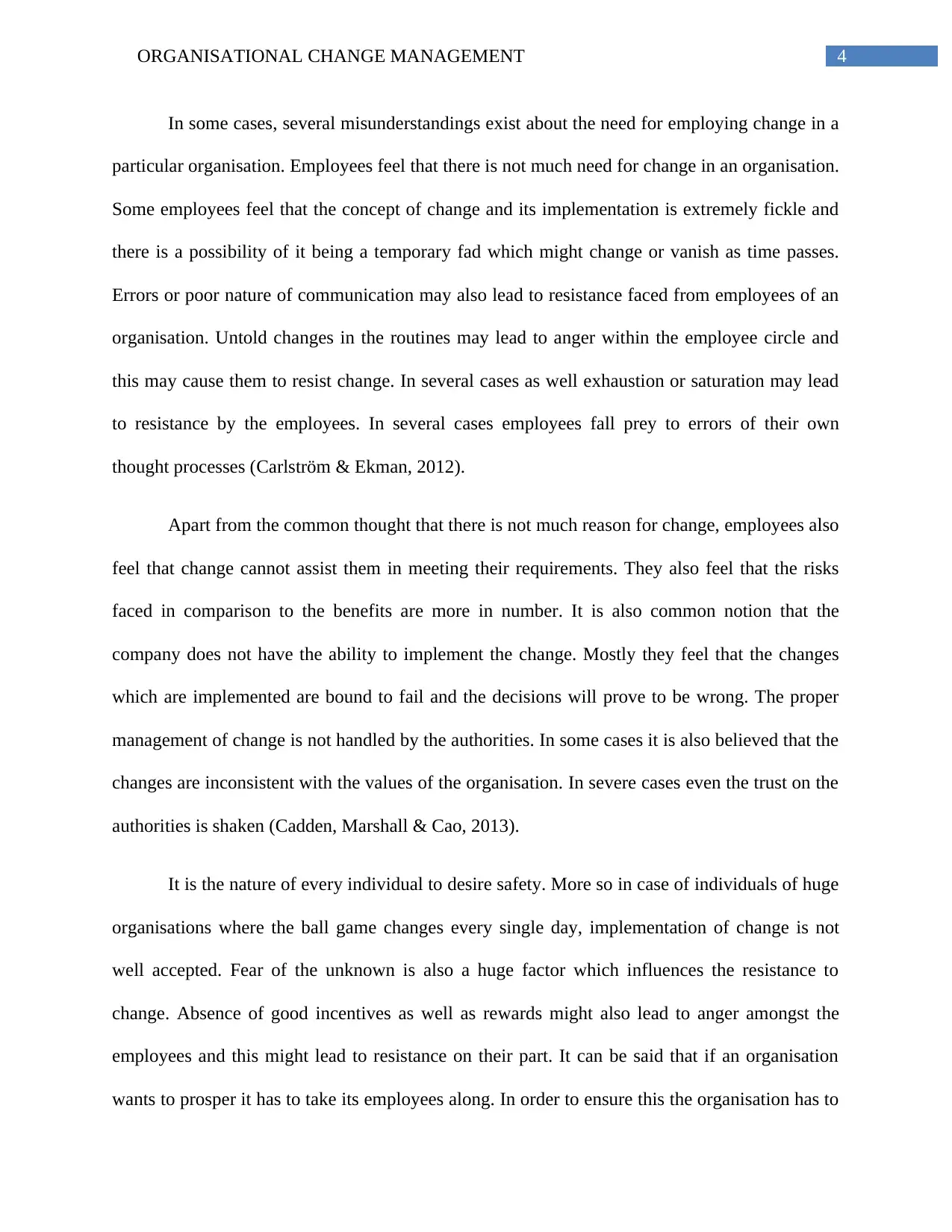
4ORGANISATIONAL CHANGE MANAGEMENT
In some cases, several misunderstandings exist about the need for employing change in a
particular organisation. Employees feel that there is not much need for change in an organisation.
Some employees feel that the concept of change and its implementation is extremely fickle and
there is a possibility of it being a temporary fad which might change or vanish as time passes.
Errors or poor nature of communication may also lead to resistance faced from employees of an
organisation. Untold changes in the routines may lead to anger within the employee circle and
this may cause them to resist change. In several cases as well exhaustion or saturation may lead
to resistance by the employees. In several cases employees fall prey to errors of their own
thought processes (Carlström & Ekman, 2012).
Apart from the common thought that there is not much reason for change, employees also
feel that change cannot assist them in meeting their requirements. They also feel that the risks
faced in comparison to the benefits are more in number. It is also common notion that the
company does not have the ability to implement the change. Mostly they feel that the changes
which are implemented are bound to fail and the decisions will prove to be wrong. The proper
management of change is not handled by the authorities. In some cases it is also believed that the
changes are inconsistent with the values of the organisation. In severe cases even the trust on the
authorities is shaken (Cadden, Marshall & Cao, 2013).
It is the nature of every individual to desire safety. More so in case of individuals of huge
organisations where the ball game changes every single day, implementation of change is not
well accepted. Fear of the unknown is also a huge factor which influences the resistance to
change. Absence of good incentives as well as rewards might also lead to anger amongst the
employees and this might lead to resistance on their part. It can be said that if an organisation
wants to prosper it has to take its employees along. In order to ensure this the organisation has to
In some cases, several misunderstandings exist about the need for employing change in a
particular organisation. Employees feel that there is not much need for change in an organisation.
Some employees feel that the concept of change and its implementation is extremely fickle and
there is a possibility of it being a temporary fad which might change or vanish as time passes.
Errors or poor nature of communication may also lead to resistance faced from employees of an
organisation. Untold changes in the routines may lead to anger within the employee circle and
this may cause them to resist change. In several cases as well exhaustion or saturation may lead
to resistance by the employees. In several cases employees fall prey to errors of their own
thought processes (Carlström & Ekman, 2012).
Apart from the common thought that there is not much reason for change, employees also
feel that change cannot assist them in meeting their requirements. They also feel that the risks
faced in comparison to the benefits are more in number. It is also common notion that the
company does not have the ability to implement the change. Mostly they feel that the changes
which are implemented are bound to fail and the decisions will prove to be wrong. The proper
management of change is not handled by the authorities. In some cases it is also believed that the
changes are inconsistent with the values of the organisation. In severe cases even the trust on the
authorities is shaken (Cadden, Marshall & Cao, 2013).
It is the nature of every individual to desire safety. More so in case of individuals of huge
organisations where the ball game changes every single day, implementation of change is not
well accepted. Fear of the unknown is also a huge factor which influences the resistance to
change. Absence of good incentives as well as rewards might also lead to anger amongst the
employees and this might lead to resistance on their part. It can be said that if an organisation
wants to prosper it has to take its employees along. In order to ensure this the organisation has to
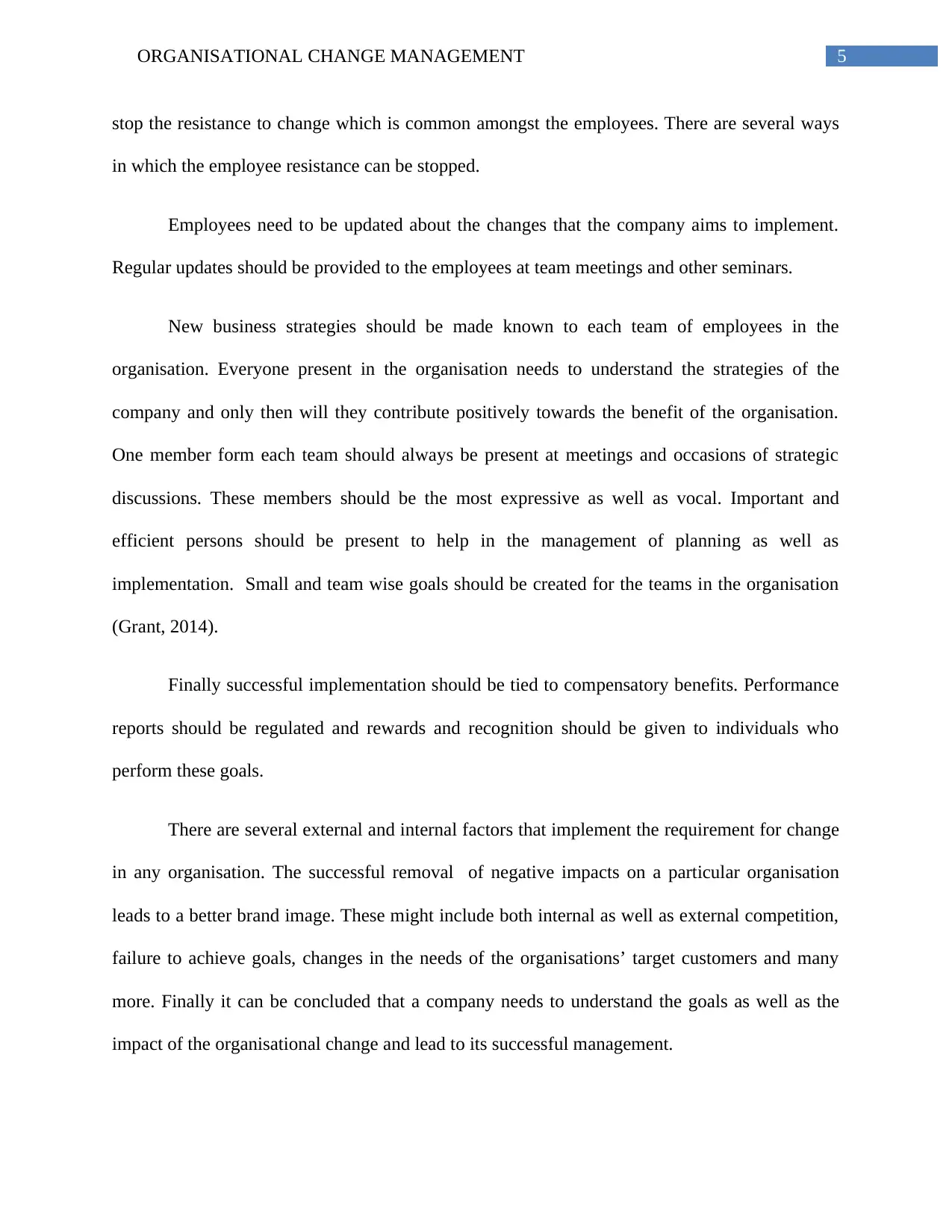
5ORGANISATIONAL CHANGE MANAGEMENT
stop the resistance to change which is common amongst the employees. There are several ways
in which the employee resistance can be stopped.
Employees need to be updated about the changes that the company aims to implement.
Regular updates should be provided to the employees at team meetings and other seminars.
New business strategies should be made known to each team of employees in the
organisation. Everyone present in the organisation needs to understand the strategies of the
company and only then will they contribute positively towards the benefit of the organisation.
One member form each team should always be present at meetings and occasions of strategic
discussions. These members should be the most expressive as well as vocal. Important and
efficient persons should be present to help in the management of planning as well as
implementation. Small and team wise goals should be created for the teams in the organisation
(Grant, 2014).
Finally successful implementation should be tied to compensatory benefits. Performance
reports should be regulated and rewards and recognition should be given to individuals who
perform these goals.
There are several external and internal factors that implement the requirement for change
in any organisation. The successful removal of negative impacts on a particular organisation
leads to a better brand image. These might include both internal as well as external competition,
failure to achieve goals, changes in the needs of the organisations’ target customers and many
more. Finally it can be concluded that a company needs to understand the goals as well as the
impact of the organisational change and lead to its successful management.
stop the resistance to change which is common amongst the employees. There are several ways
in which the employee resistance can be stopped.
Employees need to be updated about the changes that the company aims to implement.
Regular updates should be provided to the employees at team meetings and other seminars.
New business strategies should be made known to each team of employees in the
organisation. Everyone present in the organisation needs to understand the strategies of the
company and only then will they contribute positively towards the benefit of the organisation.
One member form each team should always be present at meetings and occasions of strategic
discussions. These members should be the most expressive as well as vocal. Important and
efficient persons should be present to help in the management of planning as well as
implementation. Small and team wise goals should be created for the teams in the organisation
(Grant, 2014).
Finally successful implementation should be tied to compensatory benefits. Performance
reports should be regulated and rewards and recognition should be given to individuals who
perform these goals.
There are several external and internal factors that implement the requirement for change
in any organisation. The successful removal of negative impacts on a particular organisation
leads to a better brand image. These might include both internal as well as external competition,
failure to achieve goals, changes in the needs of the organisations’ target customers and many
more. Finally it can be concluded that a company needs to understand the goals as well as the
impact of the organisational change and lead to its successful management.
⊘ This is a preview!⊘
Do you want full access?
Subscribe today to unlock all pages.

Trusted by 1+ million students worldwide
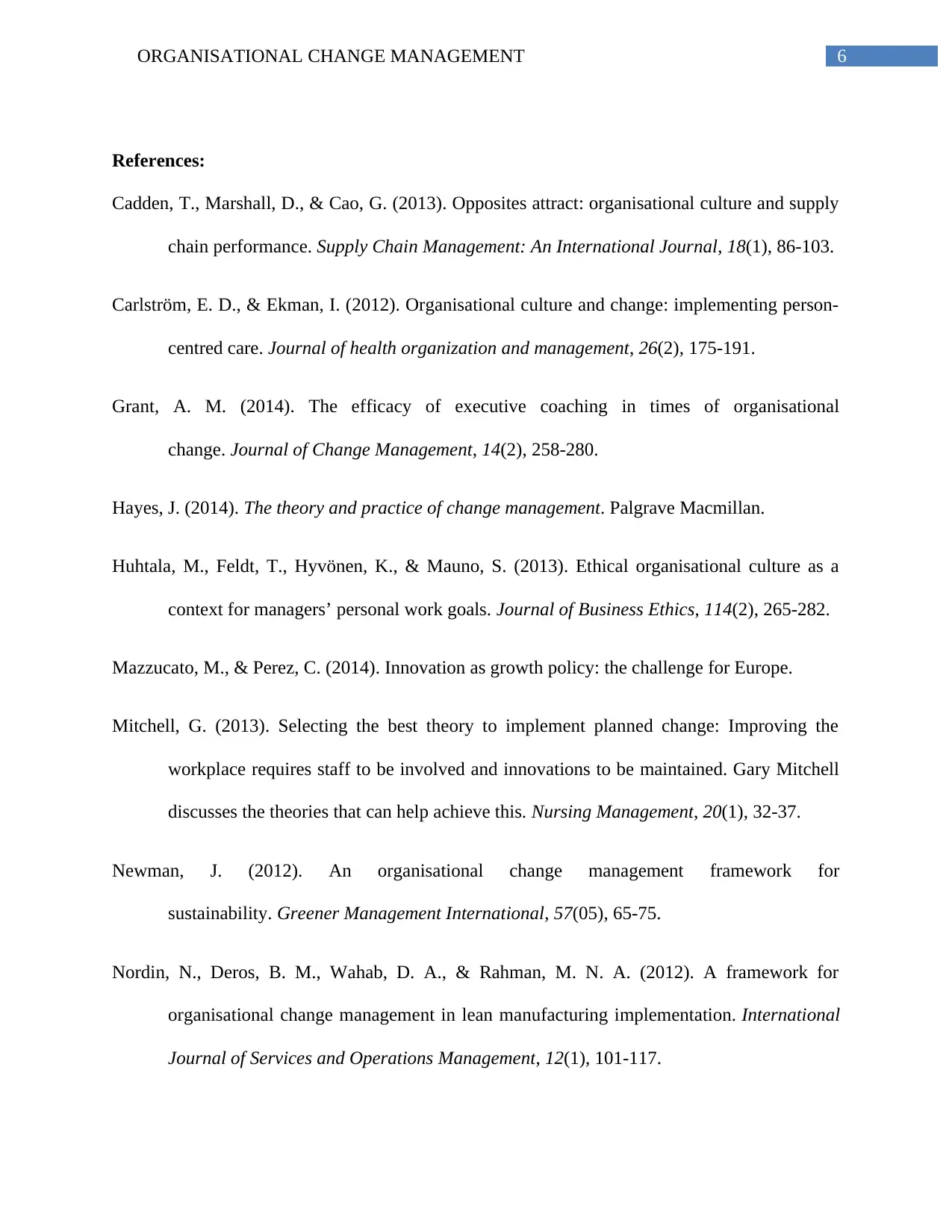
6ORGANISATIONAL CHANGE MANAGEMENT
References:
Cadden, T., Marshall, D., & Cao, G. (2013). Opposites attract: organisational culture and supply
chain performance. Supply Chain Management: An International Journal, 18(1), 86-103.
Carlström, E. D., & Ekman, I. (2012). Organisational culture and change: implementing person-
centred care. Journal of health organization and management, 26(2), 175-191.
Grant, A. M. (2014). The efficacy of executive coaching in times of organisational
change. Journal of Change Management, 14(2), 258-280.
Hayes, J. (2014). The theory and practice of change management. Palgrave Macmillan.
Huhtala, M., Feldt, T., Hyvönen, K., & Mauno, S. (2013). Ethical organisational culture as a
context for managers’ personal work goals. Journal of Business Ethics, 114(2), 265-282.
Mazzucato, M., & Perez, C. (2014). Innovation as growth policy: the challenge for Europe.
Mitchell, G. (2013). Selecting the best theory to implement planned change: Improving the
workplace requires staff to be involved and innovations to be maintained. Gary Mitchell
discusses the theories that can help achieve this. Nursing Management, 20(1), 32-37.
Newman, J. (2012). An organisational change management framework for
sustainability. Greener Management International, 57(05), 65-75.
Nordin, N., Deros, B. M., Wahab, D. A., & Rahman, M. N. A. (2012). A framework for
organisational change management in lean manufacturing implementation. International
Journal of Services and Operations Management, 12(1), 101-117.
References:
Cadden, T., Marshall, D., & Cao, G. (2013). Opposites attract: organisational culture and supply
chain performance. Supply Chain Management: An International Journal, 18(1), 86-103.
Carlström, E. D., & Ekman, I. (2012). Organisational culture and change: implementing person-
centred care. Journal of health organization and management, 26(2), 175-191.
Grant, A. M. (2014). The efficacy of executive coaching in times of organisational
change. Journal of Change Management, 14(2), 258-280.
Hayes, J. (2014). The theory and practice of change management. Palgrave Macmillan.
Huhtala, M., Feldt, T., Hyvönen, K., & Mauno, S. (2013). Ethical organisational culture as a
context for managers’ personal work goals. Journal of Business Ethics, 114(2), 265-282.
Mazzucato, M., & Perez, C. (2014). Innovation as growth policy: the challenge for Europe.
Mitchell, G. (2013). Selecting the best theory to implement planned change: Improving the
workplace requires staff to be involved and innovations to be maintained. Gary Mitchell
discusses the theories that can help achieve this. Nursing Management, 20(1), 32-37.
Newman, J. (2012). An organisational change management framework for
sustainability. Greener Management International, 57(05), 65-75.
Nordin, N., Deros, B. M., Wahab, D. A., & Rahman, M. N. A. (2012). A framework for
organisational change management in lean manufacturing implementation. International
Journal of Services and Operations Management, 12(1), 101-117.
Paraphrase This Document
Need a fresh take? Get an instant paraphrase of this document with our AI Paraphraser
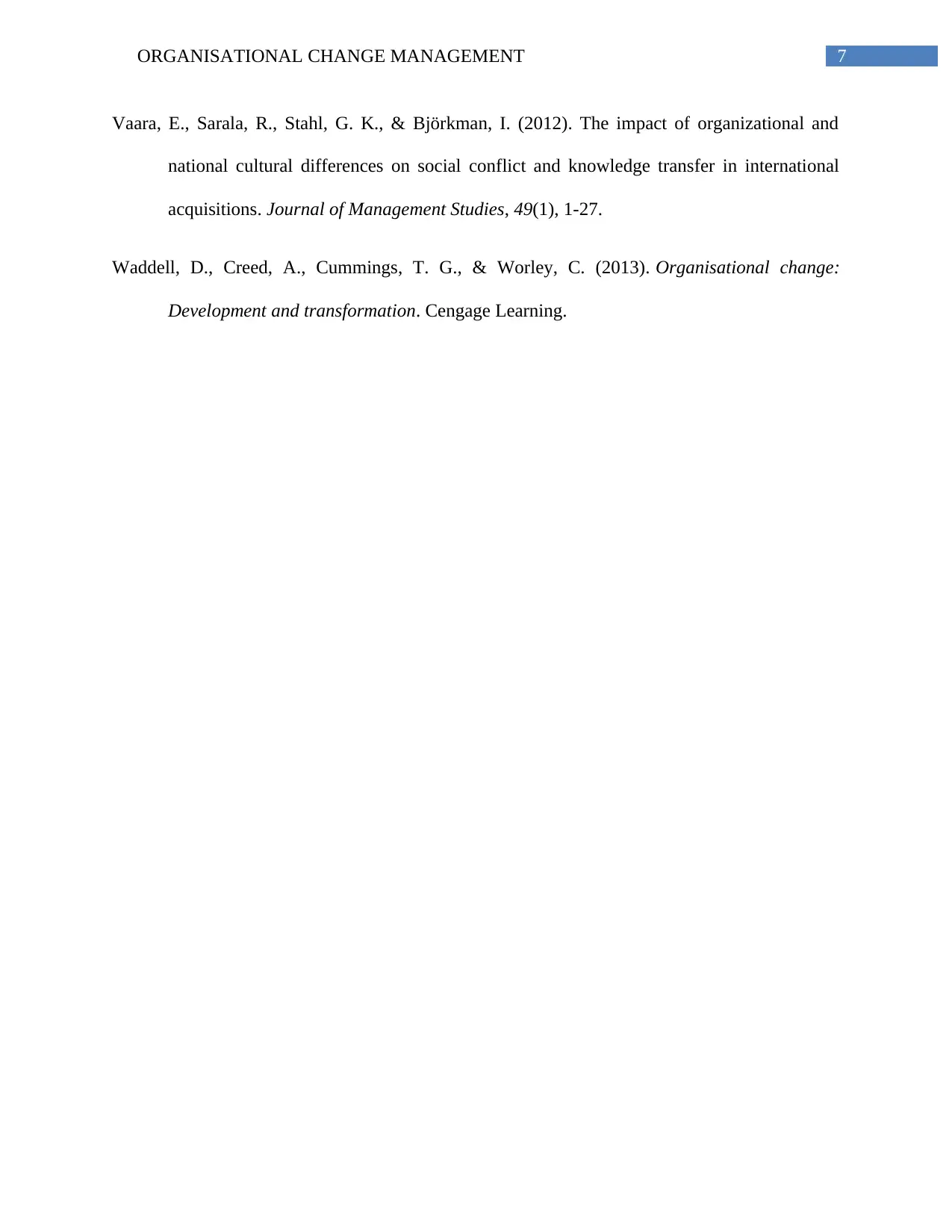
7ORGANISATIONAL CHANGE MANAGEMENT
Vaara, E., Sarala, R., Stahl, G. K., & Björkman, I. (2012). The impact of organizational and
national cultural differences on social conflict and knowledge transfer in international
acquisitions. Journal of Management Studies, 49(1), 1-27.
Waddell, D., Creed, A., Cummings, T. G., & Worley, C. (2013). Organisational change:
Development and transformation. Cengage Learning.
Vaara, E., Sarala, R., Stahl, G. K., & Björkman, I. (2012). The impact of organizational and
national cultural differences on social conflict and knowledge transfer in international
acquisitions. Journal of Management Studies, 49(1), 1-27.
Waddell, D., Creed, A., Cummings, T. G., & Worley, C. (2013). Organisational change:
Development and transformation. Cengage Learning.
1 out of 8
Related Documents
Your All-in-One AI-Powered Toolkit for Academic Success.
+13062052269
info@desklib.com
Available 24*7 on WhatsApp / Email
![[object Object]](/_next/static/media/star-bottom.7253800d.svg)
Unlock your academic potential
Copyright © 2020–2025 A2Z Services. All Rights Reserved. Developed and managed by ZUCOL.





